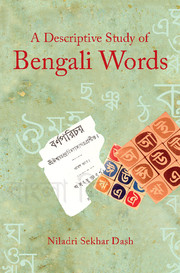Book contents
- Frontmatter
- Dedication
- Contents
- List of Tables
- Bengali Vowel Sounds in Cardinal Diagram
- Preface
- Acknowledgements
- Chapter I Word: A Conceptual Complexity
- Chapter II Usage of Some Word-formative Elements in Bengali
- Chapter III Frequency of Use of Words in Bengali
- Chapter IV Structural Components of Bengali Words
- Chapter V Use of Affixes with Bengali Words
- Chapter VI Postpositions Used in Bengali
- Chapter VII Compound Nouns and Adjectives
- Chapter VIII Structure of Reduplicated Forms in Bengali
- Chapter IX Lexical Naturalization in Bengali
- Appendix I
- Appendix II
- Appendix III
- Appendix IV
- Appendix V
- Appendix VI
- Appendix VII
- Bibliography
- Author Index
- Subject Index
Chapter IV - Structural Components of Bengali Words
Published online by Cambridge University Press: 18 December 2014
- Frontmatter
- Dedication
- Contents
- List of Tables
- Bengali Vowel Sounds in Cardinal Diagram
- Preface
- Acknowledgements
- Chapter I Word: A Conceptual Complexity
- Chapter II Usage of Some Word-formative Elements in Bengali
- Chapter III Frequency of Use of Words in Bengali
- Chapter IV Structural Components of Bengali Words
- Chapter V Use of Affixes with Bengali Words
- Chapter VI Postpositions Used in Bengali
- Chapter VII Compound Nouns and Adjectives
- Chapter VIII Structure of Reduplicated Forms in Bengali
- Chapter IX Lexical Naturalization in Bengali
- Appendix I
- Appendix II
- Appendix III
- Appendix IV
- Appendix V
- Appendix VI
- Appendix VII
- Bibliography
- Author Index
- Subject Index
Summary
Introduction
From descriptive linguistic point of view, structural analysis of word refers to anatomical analysis of morphemic structure of words. Keeping this in mind, in this chapter an attempt is made to analyse forms and functions of morphemes used in formation of Bengali words. In course of this study, an effort is also made to analyse various morphological and semantic properties of the morphemes so as to understand intricate patterns of inflection and derivation used in generation of final forms. Information obtained from structural analysis of Bengali words is a valuable input in descriptive analysis of words, as well as in language teaching, grammar book writing, and language processing. It is useful for developing a morphological processor that will identify morphemes and other formative elements that are used to generate words in Bengali. Moreover, it can also be utilized to develop a part of speech (POS) tagger that will annotate words based on their syntactic roles in a sentence within a piece of text.
There are several appropriate and approved ways of using morphemes in formation of words in Bengali. Since morphemes are quite recurrently used in different Ways and manners for word formation in Bengali, it is interesting to know which morphemes are used and in what manner for this purpose. To understand this phenomenon, it is better to take a turn from the traditional path and treat words as separate linguistic entities with unique surface structures. Based on this assumption, analysis of surface structure of words shows that morphemes are nothing but building blocks which are used to construct words that are considered as the basic units of linguistic expressions in speech and writing of a speech community.
This chapter is developed in the following ways. In the following sections some general discussion on the orthographic representation of Bengali words is presented and the general and most frequent word formation methods in Bengali are discussed.
- Type
- Chapter
- Information
- A Descriptive Study of Bengali Words , pp. 101 - 131Publisher: Cambridge University PressPrint publication year: 2015

